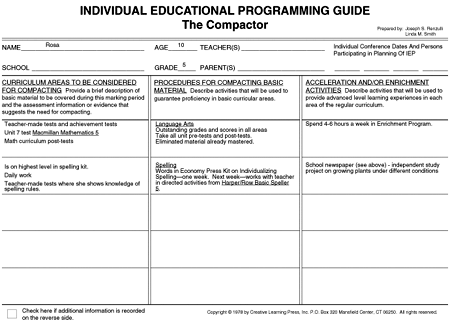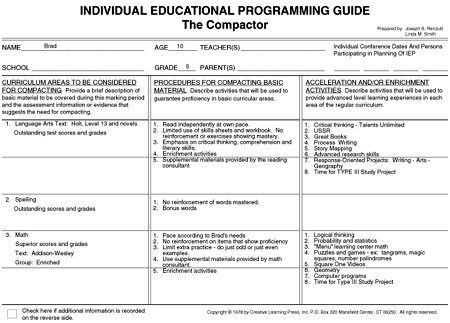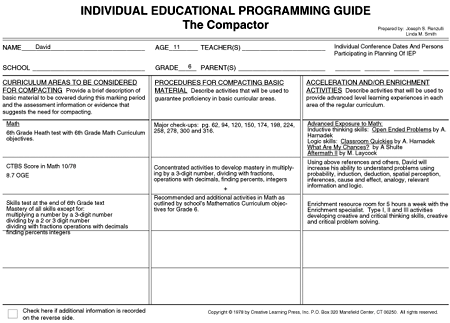
Rosa’s Compactor. (Click on the figure to see it as a PDF file.)
Rosa—Rosa is a fifth grader in a self-contained heterogeneous classroom; her school is located in a lower socio-economic urban school district. While Rosa’s reading and language scores range between four or five years above grade level, most of her 29 classmates are reading one to two years below grade level. This presented Rosa’s teacher with a common problem: what was the best way to instruct Rosa? He agreed to compact her curriculum. Taking the easiest approach possible, he administered all of the appropriate unit tests for the grade level in the Basal Language Arts program, and excused Rosa from completing the activities and worksheets in the units where she showed proficiency (80% and above). When Rosa missed one or two questions, the teacher checked for trends in those items and provided instruction and practice materials to ensure concept mastery.
Rosa usually took part in language arts lessons one or two days a week; the balance of the time she spent with alternative projects, some of which she selected. This strategy spared Rosa up to six or eight hours a week with language arts skills that were simply beneath her level. She joined the class instruction only when her pretests indicated she had not fully acquired the skills or to take part in a discussion that her teacher thought she would enjoy. In the time saved through compacting, Rosa engaged in a number of enrichment activities. First, she spent as many as five hours a week in a resource room for high ability students. This time was usually scheduled during her language arts class, benefiting both Rosa and her teacher, since he did not have to search for all of the enrichment options himself. The best part of the process for Rosa was she did not have make-up regular classroom assignments because she was not missing essential work. She became the editor of the school newspaper.
Rosa also visited a regional science center with other students who had expressed a high interest and aptitude for science. Science was a second strength area for Rosa, and based on the results of her Interest-A-Lyzer, (a questionnaire students complete to help assess their interests) a decision was made for Rosa to proceed with a science fair project on growing plants under various conditions. Rosa’s Compactor, which covered an entire semester, was updated in January. Her teacher remarked that compacting her curriculum had actually saved him time—time he would have spent correcting papers needlessly assigned! The value of compacting for Rosa convinced him that he should continue the process. The Compactor was also used as a vehicle for explaining to Rosa’s parents how specific modifications were being made to accommodate her advanced language arts achievement level and her interest in science. A copy of The Compactor was also passed on to Rosa’s sixth grade teacher, and a conference between the fifth and sixth grade teachers and the resource teacher helped to ensure continuity in dealing with Rosa’s special needs.
Brad—Brad displays strengths in language arts and mathematics. He attends a large school which has the benefit of having a reading and math consultant on the staff. Both of these consultants helped with the pretesting administered to Brad and several other high potential students from the fourth grade. Brad’s Compactor was completed by his classroom teacher who stapled the results of the pretest to the form. This explains why column one is less detailed than in other compacting examples.
Brad did regular curricular work in language arts for only one or two days a week. In spelling, he was consistently able to skip all of the drill and review work necessary to achieve perfect scores on tests, and he used the time saved to pursue advanced reading in the Great Books program.
In mathematics, he was able to master all of his fourth grade curriculum in approximately two days each week. Brad worked with three other students of similar ability in a cooperative learning group (comprised of high ability math students who all liked math) to be able to master math at this pace. The group then selected alternatives listed in column three to pursue separately or as a group during mathematics instruction time.
No gifted program existed in Brad’s district, so his classroom teacher had to work much harder to provide appropriate instruction and alternatives for column three. However, assistance was provided by the math and language-arts consultants who worked with groups of either remedial or advanced students and who also provided enrichment materials and appropriately advanced content for targeted students. The media specialist directed the independent study of students whose curriculum was compacted.
David—David is a mathematically talented student who is a sixth grader in a school district which has a policy against vertical acceleration in mathematics. Many of the districts that have participated in field tests of curriculum compacting have stated policies that do not allow students to be accelerated past their chronological grade level in any content area. Obviously, this is a dilemma for talented students and their teachers.
In David’s case, curriculum compacting resulted in the completion of his math work for the entire year in the first six weeks of school. His teacher decided to compact in this way instead of having David work with his group one day each week for the year. The teacher believed that this option worked in a more
efficient manner for his very organized, structured classroom. Also, the identification of another student with abilities similar to David’s enabled David and her to work as learning partners throughout the year.
The classroom teacher selected various mathematics enrichment activities, as described in the district’s math curriculum guide for David’s grade. He also selected several math alternative enrichment activities for David’s work in the classroom. David also spent two hours a week of his mathematics instructional time in the gifted and talented program resource room with a teacher who further enriched his math program with computer skills.
Next Section: Examining Curriculum Alternatives: Type III Opportunities for Students
Previous Section: Providing Acceleration and Enrichment Options

